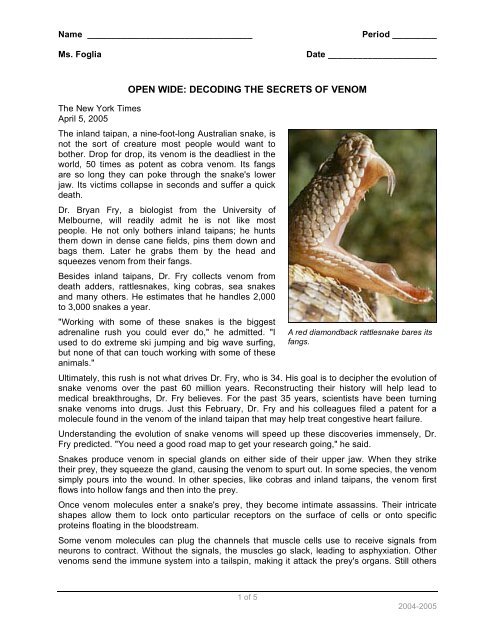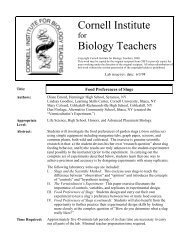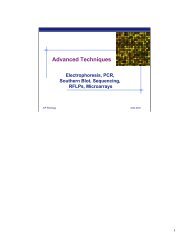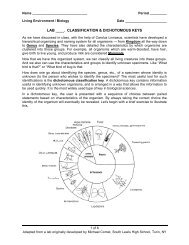open wide: decoding the secrets of venom - Explore Biology
open wide: decoding the secrets of venom - Explore Biology
open wide: decoding the secrets of venom - Explore Biology
Create successful ePaper yourself
Turn your PDF publications into a flip-book with our unique Google optimized e-Paper software.
Name __________________________________<br />
Ms. Foglia<br />
Period _________<br />
Date ______________________<br />
The New York Times<br />
April 5, 2005<br />
OPEN WIDE: DECODING THE SECRETS OF VENOM<br />
The inland taipan, a nine-foot-long Australian snake, is<br />
not <strong>the</strong> sort <strong>of</strong> creature most people would want to<br />
bo<strong>the</strong>r. Drop for drop, its <strong>venom</strong> is <strong>the</strong> deadliest in <strong>the</strong><br />
world, 50 times as potent as cobra <strong>venom</strong>. Its fangs<br />
are so long <strong>the</strong>y can poke through <strong>the</strong> snake's lower<br />
jaw. Its victims collapse in seconds and suffer a quick<br />
death.<br />
Dr. Bryan Fry, a biologist from <strong>the</strong> University <strong>of</strong><br />
Melbourne, will readily admit he is not like most<br />
people. He not only bo<strong>the</strong>rs inland taipans; he hunts<br />
<strong>the</strong>m down in dense cane fields, pins <strong>the</strong>m down and<br />
bags <strong>the</strong>m. Later he grabs <strong>the</strong>m by <strong>the</strong> head and<br />
squeezes <strong>venom</strong> from <strong>the</strong>ir fangs.<br />
Besides inland taipans, Dr. Fry collects <strong>venom</strong> from<br />
death adders, rattlesnakes, king cobras, sea snakes<br />
and many o<strong>the</strong>rs. He estimates that he handles 2,000<br />
to 3,000 snakes a year.<br />
"Working with some <strong>of</strong> <strong>the</strong>se snakes is <strong>the</strong> biggest<br />
adrenaline rush you could ever do," he admitted. "I<br />
used to do extreme ski jumping and big wave surfing,<br />
but none <strong>of</strong> that can touch working with some <strong>of</strong> <strong>the</strong>se<br />
animals."<br />
A red diamondback rattlesnake bares its<br />
fangs.<br />
Ultimately, this rush is not what drives Dr. Fry, who is 34. His goal is to decipher <strong>the</strong> evolution <strong>of</strong><br />
snake <strong>venom</strong>s over <strong>the</strong> past 60 million years. Reconstructing <strong>the</strong>ir history will help lead to<br />
medical breakthroughs, Dr. Fry believes. For <strong>the</strong> past 35 years, scientists have been turning<br />
snake <strong>venom</strong>s into drugs. Just this February, Dr. Fry and his colleagues filed a patent for a<br />
molecule found in <strong>the</strong> <strong>venom</strong> <strong>of</strong> <strong>the</strong> inland taipan that may help treat congestive heart failure.<br />
Understanding <strong>the</strong> evolution <strong>of</strong> snake <strong>venom</strong>s will speed up <strong>the</strong>se discoveries immensely, Dr.<br />
Fry predicted. "You need a good road map to get your research going," he said.<br />
Snakes produce <strong>venom</strong> in special glands on ei<strong>the</strong>r side <strong>of</strong> <strong>the</strong>ir upper jaw. When <strong>the</strong>y strike<br />
<strong>the</strong>ir prey, <strong>the</strong>y squeeze <strong>the</strong> gland, causing <strong>the</strong> <strong>venom</strong> to spurt out. In some species, <strong>the</strong> <strong>venom</strong><br />
simply pours into <strong>the</strong> wound. In o<strong>the</strong>r species, like cobras and inland taipans, <strong>the</strong> <strong>venom</strong> first<br />
flows into hollow fangs and <strong>the</strong>n into <strong>the</strong> prey.<br />
Once <strong>venom</strong> molecules enter a snake's prey, <strong>the</strong>y become intimate assassins. Their intricate<br />
shapes allow <strong>the</strong>m to lock onto particular receptors on <strong>the</strong> surface <strong>of</strong> cells or onto specific<br />
proteins floating in <strong>the</strong> bloodstream.<br />
Some <strong>venom</strong> molecules can plug <strong>the</strong> channels that muscle cells use to receive signals from<br />
neurons to contract. Without <strong>the</strong> signals, <strong>the</strong> muscles go slack, leading to asphyxiation. O<strong>the</strong>r<br />
<strong>venom</strong>s send <strong>the</strong> immune system into a tailspin, making it attack <strong>the</strong> prey's organs. Still o<strong>the</strong>rs<br />
1 <strong>of</strong> 5<br />
2004-2005
Name __________________________________<br />
<strong>Biology</strong><br />
loosen blood vessel walls, leading to shock and bleeding. Ra<strong>the</strong>r than rely on one <strong>of</strong> <strong>the</strong>se<br />
attacks, most <strong>venom</strong>ous snakes produce a cocktail <strong>of</strong> molecules.<br />
Dr. Fry says he has been fascinated by <strong>venom</strong>ous snakes ever "since I could walk." By <strong>the</strong> time<br />
he started his dissertation research on <strong>the</strong> inland taipan in <strong>the</strong> late 1990's, he was already<br />
experienced at catching snakes and milking <strong>the</strong>ir <strong>venom</strong>. To find new toxins, he would weigh<br />
<strong>the</strong> molecules in <strong>the</strong> <strong>venom</strong>, and when he found molecules that were close in weight to known<br />
<strong>venom</strong>s, he would isolate <strong>the</strong>m for a closer look.<br />
As Dr. Fry discovered more <strong>venom</strong>s, he began to wonder how <strong>the</strong>y had evolved. "It's been an<br />
area <strong>of</strong> great controversy," he said. Many researchers have argued that different lineages <strong>of</strong><br />
<strong>venom</strong>ous snakes, like rattlesnakes and cobras, evolved <strong>venom</strong> independently. They observed<br />
that <strong>the</strong> closest relatives <strong>of</strong> <strong>the</strong>se <strong>venom</strong>ous snakes were non<strong>venom</strong>ous.<br />
Dr. Fry discovered that <strong>the</strong>y were wrong. "Most <strong>of</strong> <strong>the</strong> snakes that we think <strong>of</strong> as non<strong>venom</strong>ous<br />
are actually <strong>venom</strong>ous," he explained. Garter snakes and many o<strong>the</strong>r supposedly<br />
non<strong>venom</strong>ous snakes actually produce tiny amounts <strong>of</strong> <strong>venom</strong>.<br />
Dr. Fry is quick to point out that this does not mean that garter snakes are dangerous. "All <strong>the</strong>y<br />
need to do is stun a frog or slow it down a bit, and it's enough to help <strong>the</strong>m," he said.<br />
These discoveries prompted Dr. Fry to carry out a large-scale study <strong>of</strong> <strong>the</strong> evolution <strong>of</strong> snake<br />
<strong>venom</strong>. His project would have been impossible a few years ago, because traditional methods<br />
for identifying new <strong>venom</strong>s are painfully slow. But <strong>the</strong> technology developed for <strong>the</strong> Human<br />
Genome Project has changed all that.<br />
"Instead <strong>of</strong> spending a couple months and getting two or three protein sequences done, in a<br />
month I can get up to 2,000 sequences done," Dr. Fry said. "It's an amazing increase in<br />
efficiency."<br />
"Fifteen years ago, this wouldn't even be thought <strong>of</strong>," said Alejandro Rooney, a molecular<br />
evolutionist at <strong>the</strong> National Center for Agricultural Utilization Research in Peoria, Ill., who has<br />
collaborated with Dr. Fry on some <strong>of</strong> his <strong>venom</strong> research.<br />
Dr. Fry is able to identify all <strong>of</strong> <strong>the</strong> genes that are active in <strong>venom</strong> gland cells, and <strong>the</strong>n read<br />
<strong>the</strong>ir DNA sequence. About half <strong>of</strong> <strong>the</strong> genes that are active in a <strong>venom</strong>-gland cell produce wellknown<br />
"housekeeping" proteins that are essential to any animal cell. Most <strong>of</strong> <strong>the</strong> o<strong>the</strong>rs are<br />
<strong>venom</strong>s.<br />
After identifying new toxins, including many that represent entirely new types <strong>of</strong> <strong>venom</strong>, Dr. Fry<br />
said, "I think we've just scratched <strong>the</strong> surface."<br />
Dr. Fry has constructed evolutionary trees <strong>of</strong> <strong>the</strong>se <strong>venom</strong> genes, and his results indicate that<br />
<strong>venom</strong> actually evolved only once in snakes. It started out being produced at low levels, as<br />
illustrated today by garter snakes. Later some lineages evolved a more deadly bite.<br />
"It's been <strong>the</strong> most important adaptation in <strong>the</strong> history <strong>of</strong> snakes," Dr. Fry argued. The snakes<br />
that evolved <strong>venom</strong> no longer had to rely solely on constriction or o<strong>the</strong>r ways <strong>of</strong> physically<br />
subduing <strong>the</strong>ir prey. "It's freed <strong>the</strong>m up from having to be big-muscled and slow-moving and<br />
killing <strong>the</strong>ir prey using constriction," he said. "They can be light, agile, athletic, and <strong>the</strong>y can<br />
occupy any niche from <strong>the</strong> bottom <strong>of</strong> <strong>the</strong> ocean to <strong>the</strong> top <strong>of</strong> <strong>the</strong> tallest tree."<br />
Dr. Fry's research has also shed light on <strong>the</strong> origin <strong>of</strong> <strong>venom</strong> molecules. A number <strong>of</strong><br />
researchers have suggested that <strong>venom</strong> toxins are modified saliva proteins. They point out that<br />
ordinary saliva proteins are able to start breaking down food in <strong>the</strong> mouth. Perhaps some<br />
tinkering was all that was necessary to turn <strong>the</strong>m into lethal poisons.<br />
2 <strong>of</strong> 5<br />
2004-2005
Name __________________________________<br />
<strong>Biology</strong><br />
As Dr. Fry reports in <strong>the</strong> March issue <strong>of</strong> Genome Research, <strong>the</strong> DNA <strong>of</strong> <strong>venom</strong> genes goes<br />
against this idea. He constructed evolutionary trees <strong>of</strong> 24 <strong>venom</strong> genes, searching through<br />
online databases for <strong>the</strong>ir closest relatives among non<strong>venom</strong> genes. In only two cases did he<br />
find that <strong>venom</strong> genes evolved from saliva genes. In almost all <strong>the</strong> o<strong>the</strong>r cases, <strong>venom</strong> genes<br />
evolved from ones that were active outside <strong>the</strong> <strong>venom</strong> gland — in <strong>the</strong> blood, for example, as<br />
well as <strong>the</strong> brain and liver.<br />
The evidence indicates that <strong>the</strong> evolution <strong>of</strong> a typical <strong>venom</strong> gene may begin with <strong>the</strong> accidental<br />
duplication <strong>of</strong> a gene that is active in ano<strong>the</strong>r organ. In a process known as gene recruitment,<br />
one <strong>of</strong> <strong>the</strong>se copies <strong>the</strong>n mutates in such a way that it begins producing proteins in <strong>the</strong> <strong>venom</strong><br />
gland.<br />
In some cases, <strong>the</strong>se borrowed proteins turn out to be harmful when injected into a snake's<br />
prey. Natural selection <strong>the</strong>n favors mutations that make <strong>the</strong>se proteins more lethal.<br />
"The snakes have harnessed <strong>the</strong>se proteins, changed <strong>the</strong>m and thrown <strong>the</strong>m right back at us,<br />
which is a pretty elegantly evil way <strong>of</strong> doing it," Dr. Fry said.<br />
Previous research on <strong>venom</strong> had <strong>of</strong>fered hints that some toxins might have evolved this way,<br />
but nothing more. For example, Dr. Elazar Kochva, a zoologist at Tel Aviv University, and his<br />
colleagues had noted some similarities between <strong>the</strong> <strong>venom</strong> <strong>of</strong> burrowing asps and certain<br />
enzymes in mammals. "We alluded to it, but Bryan Fry said it loud and clear and with a lot <strong>of</strong><br />
evidence," Dr. Kochva said.<br />
The concept <strong>of</strong> gene recruitment is not new, Dr. Rooney pointed out. Scientists have found<br />
evidence that it has played a role in <strong>the</strong> evolution <strong>of</strong> o<strong>the</strong>r organs, including <strong>the</strong> eye. "With<br />
<strong>venom</strong>, it seems to have occurred on a much grander scale," Dr. Rooney said.<br />
As new lineages <strong>of</strong> snakes evolved, <strong>the</strong>ir <strong>venom</strong> evolved as well. New genes were borrowed to<br />
produce new <strong>venom</strong>s, while existing <strong>venom</strong> genes duplicated many times, producing a huge<br />
diversity <strong>of</strong> molecules.<br />
This high-speed evolution allows snake <strong>venom</strong> to adapt to particular sorts <strong>of</strong> prey. Green<br />
mambas and black mambas, for example, are closely related species, but <strong>the</strong> green mambas<br />
live in trees while <strong>the</strong> black mambas live on <strong>the</strong> ground. "Not surprisingly, <strong>the</strong> black mamba<br />
<strong>venom</strong> is more potent against rats than against birds," Dr. Fry said, "while <strong>the</strong> green mamba<br />
<strong>venom</strong> is more potent to <strong>the</strong> birds than against rats."<br />
This rapid evolution has produced a wealth <strong>of</strong> complex molecules that researchers have barely<br />
begun to investigate. Evolutionary trees can serve as guides, speeding <strong>the</strong> search for new<br />
<strong>venom</strong>s and shedding light on how <strong>venom</strong>s work. "Just looking by chance is very difficult and<br />
not economical," Dr. Kochva said.<br />
The <strong>venom</strong> molecules that Dr. Fry has isolated from <strong>the</strong> inland taipan is a case in point. He has<br />
established that <strong>the</strong>y evolved from a family <strong>of</strong> proteins known as natriuretic peptides. In snakes,<br />
humans and o<strong>the</strong>r vertebrates, <strong>the</strong>se peptides relax <strong>the</strong> muscles around <strong>the</strong> heart.<br />
In <strong>the</strong> ancestors <strong>of</strong> <strong>the</strong> inland taipan, <strong>the</strong> genes for natriuretic peptides began producing <strong>the</strong>se<br />
proteins in <strong>the</strong> <strong>venom</strong> glands. Over time, <strong>the</strong>ir muscle-relaxing ability increased. Now <strong>the</strong>y can<br />
stop <strong>the</strong>ir prey's aorta from contracting at all.<br />
"They drop <strong>the</strong> blood pressure, which will knock <strong>the</strong> prey out," Dr. Fry said. "That gives <strong>the</strong><br />
slower, but more lethal toxins a chance to exert <strong>the</strong>ir effects." These slower toxins create<br />
swarms <strong>of</strong> clots in a prey's bloodstream, setting <strong>of</strong>f a vast number <strong>of</strong> strokes. "It's a good onetwo<br />
punch."<br />
3 <strong>of</strong> 5<br />
2004-2005
Name __________________________________<br />
<strong>Biology</strong><br />
Dr. Fry and his colleagues report <strong>the</strong>ir study <strong>of</strong> <strong>the</strong>se toxins in<br />
<strong>the</strong> Feb. 25 issue <strong>of</strong> Biochemical and Biophysical Research<br />
Communications.<br />
They are investigating <strong>the</strong> heart-relaxing toxins for treatment <strong>of</strong><br />
congestive heart failure. By making blood vessels around <strong>the</strong><br />
heart relax, it may be possible to increase <strong>the</strong> flow <strong>of</strong> blood out<br />
<strong>of</strong> <strong>the</strong> heart.<br />
Understanding <strong>the</strong> evolution <strong>of</strong> <strong>the</strong>se <strong>venom</strong>s helps Dr. Fry<br />
and his colleagues figure out how <strong>the</strong>y work. Because <strong>the</strong>y<br />
have evolved from proteins that only act on <strong>the</strong> heart, <strong>the</strong>y<br />
probably will not pose a risk to o<strong>the</strong>r parts <strong>of</strong> <strong>the</strong> body.<br />
"If you want to use a <strong>venom</strong> for some kind <strong>of</strong> drug, you'd better<br />
look back and see where it came from," Dr. Kochva said.<br />
Dr. Fry knows that few people are as fond <strong>of</strong> deadly snakes as<br />
he is. But he hopes that <strong>the</strong>se sorts <strong>of</strong> discoveries help lead to<br />
<strong>the</strong> protection <strong>of</strong> <strong>the</strong> world's snakes.<br />
"If you kill <strong>of</strong>f <strong>the</strong> snakes, you could be killing <strong>the</strong> next wonder<br />
drug," he said.<br />
4 <strong>of</strong> 5<br />
2004-2005
Name _____________________________<br />
<strong>Biology</strong><br />
5 <strong>of</strong> 5

















